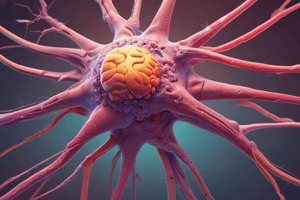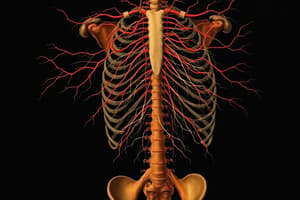Podcast
Questions and Answers
Which of the following scenarios would most likely result from the activation of the baroreceptor reflex?
Which of the following scenarios would most likely result from the activation of the baroreceptor reflex?
- Increased sympathetic activity leading to increased vascular resistance and increased cardiac output. (correct)
- Decreased sympathetic activity leading to increased vascular resistance and decreased cardiac output.
- Increased parasympathetic activity leading to decreased heart rate and vasodilation.
- Decreased parasympathetic activity leading to decreased vascular resistance and increased cardiac output.
A researcher is studying the effects of a novel compound on autonomic ganglia. If the compound selectively blocked N sub N receptors, which of the following outcomes would be expected?
A researcher is studying the effects of a novel compound on autonomic ganglia. If the compound selectively blocked N sub N receptors, which of the following outcomes would be expected?
- Inhibition of both sympathetic and parasympathetic postganglionic nerve transmission. (correct)
- Increased skeletal muscle contraction.
- Selective inhibition of sympathetic postganglionic nerve transmission.
- Selective inhibition of parasympathetic postganglionic nerve transmission.
A patient is administered a drug that selectively stimulates muscarinic receptors. Which of the following physiological responses would most likely be observed?
A patient is administered a drug that selectively stimulates muscarinic receptors. Which of the following physiological responses would most likely be observed?
- Decreased heart rate, bronchoconstriction, and increased gastrointestinal motility. (correct)
- Increased heart rate, bronchodilation, and increased gastrointestinal motility.
- Decreased heart rate, bronchodilation, and increased gastrointestinal motility.
- Increased heart rate, bronchodilation, and decreased gastrointestinal motility.
A toxin selectively destroys the preganglionic neurons of the sympathetic nervous system. Which of the following physiological changes would be expected as a direct consequence of this exposure?
A toxin selectively destroys the preganglionic neurons of the sympathetic nervous system. Which of the following physiological changes would be expected as a direct consequence of this exposure?
A drug is developed that selectively blocks N sub m receptors. Which of the following would be the most likely therapeutic use for this drug?
A drug is developed that selectively blocks N sub m receptors. Which of the following would be the most likely therapeutic use for this drug?
If a researcher applies acetylcholine to a sample of skeletal muscle tissue, what receptor type would mediate the resulting muscle contraction?
If a researcher applies acetylcholine to a sample of skeletal muscle tissue, what receptor type would mediate the resulting muscle contraction?
Which of the following correctly describes the anatomical relationship between preganglionic and postganglionic neurons in the sympathetic and parasympathetic nervous systems?
Which of the following correctly describes the anatomical relationship between preganglionic and postganglionic neurons in the sympathetic and parasympathetic nervous systems?
Epinephrine released from the adrenal medulla has a diffuse effect on the body because:
Epinephrine released from the adrenal medulla has a diffuse effect on the body because:
Why is acetylcholine considered the first neurotransmitter in both sympathetic and parasympathetic pathways?
Why is acetylcholine considered the first neurotransmitter in both sympathetic and parasympathetic pathways?
Which of the following best describes the neurohumoral transmission involving epinephrine?
Which of the following best describes the neurohumoral transmission involving epinephrine?
A patient presents with hypotension and decreased renal blood flow. If dopamine is administered to improve renal blood flow, which receptor is primarily responsible for mediating this effect?
A patient presents with hypotension and decreased renal blood flow. If dopamine is administered to improve renal blood flow, which receptor is primarily responsible for mediating this effect?
A researcher discovers a new compound that selectively enhances the activity of preganglionic neurons in the parasympathetic nervous system. Which of the following effects would be most likely observed in an experimental animal?
A researcher discovers a new compound that selectively enhances the activity of preganglionic neurons in the parasympathetic nervous system. Which of the following effects would be most likely observed in an experimental animal?
If a drug inhibits acetylcholinesterase (the enzyme that breaks down acetylcholine) at the neuromuscular junction, what would be the most likely direct effect on skeletal muscle?
If a drug inhibits acetylcholinesterase (the enzyme that breaks down acetylcholine) at the neuromuscular junction, what would be the most likely direct effect on skeletal muscle?
A patient with a pheochromocytoma (a tumor of the adrenal medulla) would likely exhibit which of the following symptoms due to the excessive release of epinephrine?
A patient with a pheochromocytoma (a tumor of the adrenal medulla) would likely exhibit which of the following symptoms due to the excessive release of epinephrine?
A surgical error results in damage to the craniosacral outflow of the parasympathetic nervous system. What broad category of physiological functions would be most directly affected?
A surgical error results in damage to the craniosacral outflow of the parasympathetic nervous system. What broad category of physiological functions would be most directly affected?
Flashcards
Nervous System
Nervous System
Divisions include: Central Nervous System (CNS) and Peripheral Nervous System (PNS).
Efferent Division
Efferent Division
Efferent division includes the autonomic (parasympathetic, sympathetic, enteric) and somatic systems.
Baroreceptor Reflex
Baroreceptor Reflex
Drop in blood pressure leads to reduced baroreceptor stretch, decreasing afferent impulses to the medulla, triggering an autonomic response.
Preganglionic Neurons
Preganglionic Neurons
Signup and view all the flashcards
Postganglionic Neuron
Postganglionic Neuron
Signup and view all the flashcards
Sympathetic Fibers
Sympathetic Fibers
Signup and view all the flashcards
Parasympathetic Fibers
Parasympathetic Fibers
Signup and view all the flashcards
Receptors
Receptors
Signup and view all the flashcards
Nicotinic N Receptor
Nicotinic N Receptor
Signup and view all the flashcards
Nicotinic M Receptor
Nicotinic M Receptor
Signup and view all the flashcards
Muscarinic Receptors
Muscarinic Receptors
Signup and view all the flashcards
Alpha and Beta Receptors
Alpha and Beta Receptors
Signup and view all the flashcards
Sympathetic Ganglia
Sympathetic Ganglia
Signup and view all the flashcards
Somatic Motor Nerves
Somatic Motor Nerves
Signup and view all the flashcards
Neurohumoral Transmission
Neurohumoral Transmission
Signup and view all the flashcards
Study Notes
Divisions of the Nervous System
- Central nervous system (CNS)
- Peripheral nervous system (PNS)
- Efferent division contains autonomic nervous system, parasympathetic, sympathetic pathways, enteric nervous system and somatic system
Anatomy of the Autonomic Nervous System
- Afferent neurons play a key role in reflex regulations, exemplified by the baroreceptor reflex
- Drop in blood pressure leads to reduced stretch of baroreceptors which results in reduced afferent impulses to the medulla
- Reduced afferent impulses trigger an autonomic response to increase blood pressure by inhibiting parasympathetic and activating sympathetic pathways
- This increases vascular resistance and cardiac output to elevate blood pressure
- Afferent neurons include preganglionic and postganglionic neurons, emphasizing ganglia
- Preganglionic neurons originate in the CNS and synapse in ganglia
- Postganglionic neurons start in the ganglia and connect to target organs
Sympathetic vs Parasympathetic Fibers
- Sympathetic fibers originate in the thoracolumbar region of the spinal cord, with ganglia running parallel (paravertebral)
- Parasympathetic fibers originate in the craniosacral regions of the spinal cord
Autonomic Receptors
- Receptors are key to understanding autonomic pharmacology
- Key diagrams include the autonomic pathways and receptor locations
Nicotinic Receptors
- Two Subtypes: N sub N, and N sub M
- N sub N are found at ganglia, adrenal medulla and in the brain
- N sub M are found at neuromuscular junctions on skeletal muscle
Muscarinic Receptors
- Primarily associated with the parasympathetic nervous system
- Located on parasympathetic target organs and sweat glands (sympathetic)
Alpha and Beta Adrenergic Receptors
- Found on organs innervated by the sympathetic nervous system
Ganglia Placement
- Parasympathetic ganglia are close to target organs, with long preganglionic and short postganglionic fibers
- Sympathetic ganglia are near the spinal cord, with short preganglionic and long postganglionic fibers
Somatic Motor Nerves
- Under voluntary control
- Single myelinated motor neuron travels directly to skeletal muscle without ganglia mediation
Primary Neurotransmitters
- Acetylcholine
- Norepinephrine
- Epinephrine
- Dopamine plays a smaller role
Rule #1: First Neurotransmitter
- Acetylcholine is the first neurotransmitter in parasympathetic, sympathetic, and somatic pathways
Rule #2: First Receptor
- The first receptor is always nicotinic (N sub N or N sub M)
Acetylcholine Function
- Mediates nerve impulse transmission across autonomic ganglia (sympathetic and parasympathetic)
- Acts as a transmitter at the adrenal medulla and neuromuscular junction
Norepinephrine (NE)
- Activates alpha and beta receptors on organs innervated by the sympathetic nervous system
Epinephrine (EPI)
- Released from adrenal medulla into the bloodstream
- Binds to and activates adrenergic receptors (alpha and beta)
Neurohumoral Transmission
- Epinephrine release from the adrenal medulla into the bloodstream
- Adrenal medulla is nervous tissue, similar to ganglia, receiving acetylcholine signals
Analogy for NE and EPI
- Norepinephrine acts in a pinpoint-accurate manner at specific locations innervated by sympathetic nerves
- Epinephrine is released into the bloodstream and affects tissues where the blood goes
Dopamine in the Peripheral Nervous System
- Acts on D1 receptors on kidney blood vessels, causing vasodilation and increased renal blood flow.
Studying That Suits You
Use AI to generate personalized quizzes and flashcards to suit your learning preferences.




